Burning the Midnight Oil for Living Energy Independence
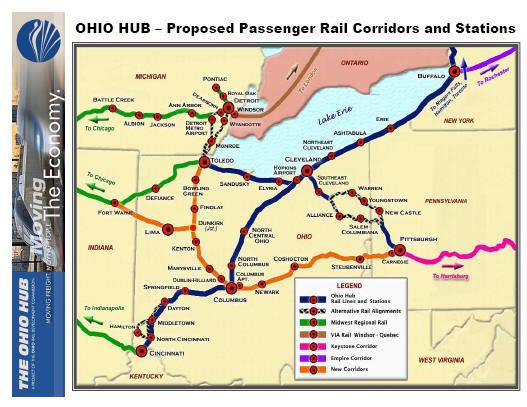 One of the stories that came out into the press this week was the pledge by the US Department of Transport to look into extending the designated HSR corridors to include Pittsburgh/Cleveland.
One of the stories that came out into the press this week was the pledge by the US Department of Transport to look into extending the designated HSR corridors to include Pittsburgh/Cleveland.This would extend the Cleveland/Chicago route via northern Indiana and connect with the Triple-C route at Cleveland (both currently competing for HSR Stimulus funding). This is a 145 mile alignment that would offer a 2:10 Express trip between these two cities as a 110mph corridor, for a 67mph route speed - and faster, of course, if later upgraded to a 125mph Regional HSR corridor.
The focus today is not, however, High Speed Rail - it is conventional rail. The focus is on how to take this alignment that hit the top northeast corner of Akron's Summit County and leverage it into effective rail service for the Canton-Akron area.
Intercity Connections Along the Corridor
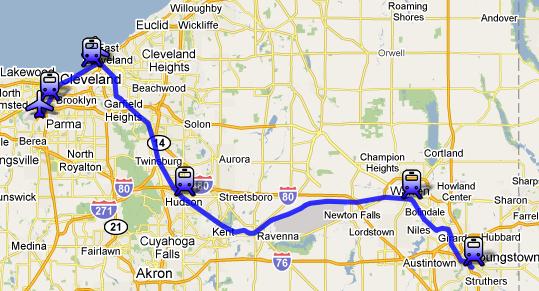 In the figure, I have isolated the Youngstown/Cleveland section of the corridor. In Cleveland, I've continued from the downtown Amtrak station next to Browns Stadium along the Triple C corridor to the Puritas Avenue intermodal station, then ended up on the Red Line to Hopkins Airport (see disclaimer below).
In the figure, I have isolated the Youngstown/Cleveland section of the corridor. In Cleveland, I've continued from the downtown Amtrak station next to Browns Stadium along the Triple C corridor to the Puritas Avenue intermodal station, then ended up on the Red Line to Hopkins Airport (see disclaimer below).Along the route, I have given a rough indication of the station locations (other than downtown Cleveland and Puritas Avenue, these have not been pinned down), and the airports that lie directly adjacent to this alignment. Youngstown / Downtown Cleveland is 1:17 in the all-HSR-stations schedule, so a conventional rail service would fall within 1:50.
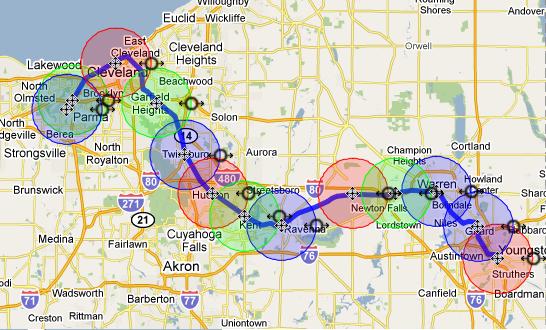 Of course, these are not enough stations for a conventional rail route. The second figure shows the result of adding stations in smaller population centers and then filling in to get most of the corridor within 5 miles of a station. This is a total of 13 stations - the original five stations plus the Hopkins airport terminus, plus seven intermediate stations.
Of course, these are not enough stations for a conventional rail route. The second figure shows the result of adding stations in smaller population centers and then filling in to get most of the corridor within 5 miles of a station. This is a total of 13 stations - the original five stations plus the Hopkins airport terminus, plus seven intermediate stations.Disclaimer: This is not an official plan, an official preliminary plan or even a necessarily fully worked out sketch of an outline of a plan. Its just an idea. So if you ask, "why didn't you ..." don't be surprised if the suggestion shows up in an updated version of one of these figures.
Now, on the one hand, for those living along the alignment, this would be a substantial upgrade in terms of their range of available transport options. And given the very light usage of the preferred HSR rail alignment between Kent and Youngstown, it represents an opportunity to establish a conventional rail service at a substantial savings in capital costs.
On the other hand, it misses Akron, and while passing through the north of Kent, lies well beyond regular walking distance from Kent State University. Is there anything that can be done to fix that?
Adding Akron to the System
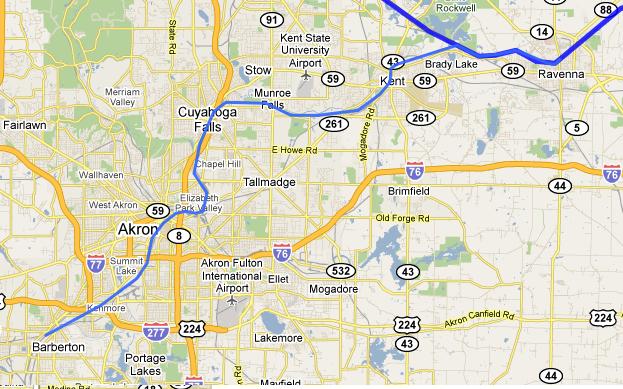 The rail corridor in the preferred Ohio Hub alignment is a branch line to Youngstown, and it does in fact has a connection to Akron. So in this figure, I've run a line from the first station west of the branch down through Kent, Cuyahoga Falls, Akron, past Akron University, and terminating in Barberton.
The rail corridor in the preferred Ohio Hub alignment is a branch line to Youngstown, and it does in fact has a connection to Akron. So in this figure, I've run a line from the first station west of the branch down through Kent, Cuyahoga Falls, Akron, past Akron University, and terminating in Barberton.For local transport, this is a reasonable alignment - it runs right by Akron University, close to Kent State University, and a short bus or shuttle ride from main hospital in Portage County and a major shopping mall in Summit County. However, for intercity travel, its less than ideal - it makes is straightforward to get from Akron to Youngstown (!), but not to get from Akron to Cleveland. It also completely omits Canton, and the Pro Football Hall of Fame, as well as the Canton Akron Airport.
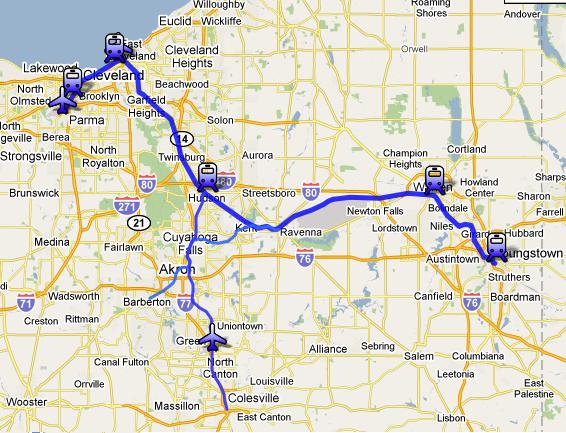 So the Canton/Akron intercity line runs from Canton (note that Google Maps for some reason has a grudge against Canton itself) past CAK Airport, connecting with the University Line at Cuyahoga Falls, then up to join the HSR corridor south of the Summit County HSR station in Hudson.
So the Canton/Akron intercity line runs from Canton (note that Google Maps for some reason has a grudge against Canton itself) past CAK Airport, connecting with the University Line at Cuyahoga Falls, then up to join the HSR corridor south of the Summit County HSR station in Hudson. The full Cleveland, Akron, Canton, Youngstown system would have about 20 stations, as illustrated in the figure, offering substantial access through the Northeastern Ohio area.
The full Cleveland, Akron, Canton, Youngstown system would have about 20 stations, as illustrated in the figure, offering substantial access through the Northeastern Ohio area.Operations on the Canton Akron system
Clearly the Intercity traffic between Cleveland and Youngstown/Warren will be strongly drawn to the HSR service itself. Therefore the cornerstone of the operation is the Canton/Cleveland line, which would run in sync with the HSR services, operating as an intercity service in its own right, a collector into Hudson and distributor out of Hudson for the HSR corridor, and as an airport transfer from both Hopkins and Canton-Akron airports.
This leaves the Universities line to run from Barberton through Akron University and Akron, Kent, and then west serving the local and HSR stations along the alignment to Youngstown - ending near Youngstown State (how close depends, of course on the siting of the Youngstown HSR station).
If there is sufficient demand for additional services from Southeast Cleveland to downtown and the airport, a final set of services might be added from Ravenna to Cleveland, synchronized with the Universities line.
And under current conditions, competing against heavily subsidized automobile transport, and (unlike the HSR service) operating more slowly then direct automobile transport except during rush hour - all of these services will be running an operating loss.
Cap'n Transit has been pursuing the question of how to generate a profit (or, more modestly, and operating surplus) with transit lines, and has arrived at a Magic Formula:
1. Give transit its own right-of-way and good terminals
2. Make it hard to use cars
3. Make it expensive to use cars
4. Profit!
That suggests that as repeated oil price shocks hit in the decade ahead, it should become profitable to operate transit lines at a profit everywhere it is hard to use cars - which is automatically the case in densely populated urban areas. As he discusses, even if it becomes more expensive to use cars, given the diverse population, both (2) and (3) is necessary to arrive at the high mode shares that yield profits for transit lines.
The proposed system would qualify as providing dedicated right of way. Good terminals are not automatic, but the capital efficiency of sharing infrastructure with the HSR line makes it an easier goal to hit. But its not likely to become hard to use cars in most of the area covered by this line.
So that provides the frame if something like the Northeast Ohio Regional Rail is going to be established in present conditions. No matter how much capital efficiencies are gained by leveraging work done to establish the HSR corridor - unless there is a way of covering the operating loss.
Financing Operations of the Northeast Ohio Regional Rail System
There are, however, still a lot of potential wins in the system. Most important, in the eyes of people in Northeast Ohio, is likely to be the jobs impact. As discussed at Streetsblog Capital Hill, the American Public Transport Association reports that public transport spending has been shown to create as many jobs as highway spending - but with greater spending on operating subsidies would create more. Comparing the jobs impact of a billion dollars spent on public transport:
- Capital Spending: 23,788 total jobs (8,202 direct, 7,875 indirect, 7,111 induced)
- Operating Spending: 41,140 total jobs (21,227 direct, 2,934 indirect, 16,979 induced)
With our current mix of Federal spending, public transport spending generates just over 30,000 jobs per $1b - equivalent to highway spending. But that is due to the 69:31 split between capital and operating subsidies. Release the restrictions on operating subsidies to areas where populations exceed 200,000, and the jobs created by the public transport operating subsidies would be substantially higher.
 An important step in increasing the jobs impact of operating subsidies in this case is to electrify the system, since this will cut the share of operating costs that goes to powering the system, leaving a higher share for paying workers. "Sunday Train: Supporting Rail Electrification with the Climate Bill" offers one framework for supporting this work by permitting states to allocated a portion of their share of Carbon Fee revenue to providing interest subsidies for transport electrification. Another section in the same framework would provide Funds for Energy Efficient Transport accounts to local municipalities and counties - and a portion of this could also be used to support electrification of the rail corridor.
An important step in increasing the jobs impact of operating subsidies in this case is to electrify the system, since this will cut the share of operating costs that goes to powering the system, leaving a higher share for paying workers. "Sunday Train: Supporting Rail Electrification with the Climate Bill" offers one framework for supporting this work by permitting states to allocated a portion of their share of Carbon Fee revenue to providing interest subsidies for transport electrification. Another section in the same framework would provide Funds for Energy Efficient Transport accounts to local municipalities and counties - and a portion of this could also be used to support electrification of the rail corridor.If Federal operating subsidies were available, the investment in electrification would lower operating costs and (by reducing the time required to stop at stations) increase trips speeds and therefore patronage, and would therefore stretch the operating subsidies go further. However, it is unlikely to be enough to cover the cost.
There is a local source of funds that could be used to help provide local operating subsidies. Establishing the rail corridor will increase property values in the vicinity of the new train stations. This will lead to an increase in property tax receipts. So one source of operating revenue would be to allocate a portion of the increase in property tax receipts to subsidies of the rail operation.
Indeed, as argued in Sunday Train: Rapid Streetcars and Suburban Retrofit, this effect, which naturally follows the establishment of a useful new transport route, can be substantially leveraged with a zoning easement that relaxes single-use, single-residence zoning restrictions and allows for multiple use and multiple residence within a given radius of the train station - the specific example was a two-tiered system of multiple use within a quarter mile radius and up to four residences per lot (through stacked townhouses) within a half mile radius.
In suburban areas, that zoning easement increases the potential number of properties that can benefit from the presence of the train station. Indeed, the transport operating levy may well be focused on those properties that take advantage of the easement.
A second source of direct operating subsidies should be congestion pricing on those roads that are congested - which is to say, in the more densely populated areas during peak traffic periods. As Ryan Avent argues in Streetsblog San Francisco, Congestion Pricing: Still Good For Basically Everyone. The revenue source for transit is an obvious benefit to transit riders. At the same time, those that continue to drive get to drive on less congested roads. And driving on less congested roads then has spillover benefits all around - including costs of congestion that we frequently overlook:
The results suggest that traffic congestion is a significant contributor to poor health in affected infants. Estimates of the costs of traffic congestion should account for these important health externalities.
Will this close the circle, or will additional revenue sources be required? That I do not know. However it will in any event partly close the circle, and leave a system that is not overly dependent on a single source of funding, such as the systems funded by a portion of sales tax revenues that have been finding their revenue drying up even as difficult economic times are increasing the numbers of people looking to rely on public transport.
Substantial further work would be required to estimate incremental capital costs and potential patronage on the two proposed rail corridors, and work up both capital and operating budgets. However, a final advantage of the proposed system is that it is possible for it to start small and grow:
- A first stage would run as a shuttle from the corridor east of Kent through Akron U, and then up to the Hudson HSR station
- A second stage would extend the shuttle on through to Cleveland after the HSR service has passed
- The third stage completes the local stations along the Youngstown corridor to provide the full Universities Line service, reversing at the University of Akron to connect to the HSR corridor at Hudson
- Then the fourth stage would complete the Universities line out to Barberton and the Canton/Akron line to Canton
As a staged system, with the first stage looking to coincide with the start of the Pittsburgh/Cleveland HSR service, it would have an opportunity to establish its operating funding and build its market.
So, construction of the Pittsburgh/Cleveland HSR corridor, on the preferred alignment, does provide opportunities to share rail infrastructure with a Northeast Ohio Regional Rail System providing local conventional rail transport. However, barring dramatic changes in both the cost and ease of automobile transport in the region, actually operating the system would require establishing sources of operating funds over and above farebox revenue.
The strategy contemplated here is, first, capital investment to narrows the operating deficit, public transport property tax levies that recover some of the gains in property value created by the system, and congestion fees to offer alternatives to congested roadways while offering drivers willing to pay for their use of the road a less congested road, with all the spillover benefits in terms of health and energy efficiency that comes from reduced traffic congestion.
OTOH, you may have a better idea - or additional idea - so the floor is open.
UPDATE This just in from Transport for America (T4America.org):
Thank senators for making clean transportation part of the climate bill
The authors of the Senate climate bill have decided to support serious investment in cleaner transportation options. And it only makes sense – transportation pollution is responsible for nearly one-third of our national greenhouse gas emissions.
The bill will secure funding for clean transportation alternatives, such as public transportation and passenger rail, affordable neighborhoods around transit stops, vanpooling and neighborhood projects that increase safety for cyclists and pedestrians.
Please thank your senators for moving forward on this landmark bill and ask them to continue to support strong transportation measures in the climate bill.
Follow the link to send an expression of support to your Senators.
Midnight Oil: Beds Are Burning


No comments:
Post a Comment